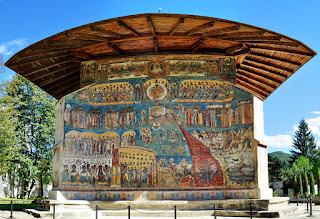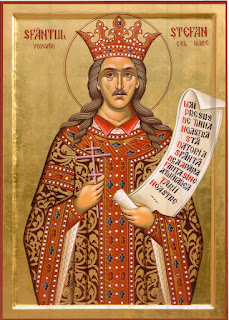
Saint Martyr Christopher is an important saint in the Christian memory both in the West and in the East, his name being in the same time the definition of his beautiful Christian life: “Christo-phoros” means in greek “Christ-Bearer”, and because of that, he is often represented as carrying Jesus the Child on his shoulders. Many times, the Christian believers can see his other icon, which is quite strange, because the saint has a dog-head. This thing is quite rare in the Christianty and may be associated with the old Egyptian iconography of the god Anubis, who is represented with a jackal-face, but a human corpse. This ancient god is the protector of the souls passing from this life to the eternal, so it is quite interesting that St. Christopher is also the protector of the travelers and passengers.

The Kinokephaloi – the men with dog-heads
In the greek version of Christopher’s life, he came in the Roman Empire through the lands of the Persians, so it could be believed that he came from India, maybe from this tribe.
Who was St. Christopher?

Two stories
The Eastern Synaxarion and Legenda Aurea mention that St. Christopher lived in the period of the ruling of Decius, around 250 AD, but another variant of his life places him later, during the reign of Maximinus Daia, about 300 AD. The latin legend names him as a Cannanite, but in the meantime the Synaxarion says that he came from the Eastern Lands beyond Persia. Both histories mention about the hateful-looking of this giant soldier of the Roman Empire, who had a good heart and tried to help the captive Christians. His name is “Reprobus”, a Latin name who sends to the understanding of his ugliness. On the second variant, Christopher was a very beautiful man who prayed to the Lord to take from him his beauty, because he provoked scandal among the women. In the end, God hears his praying and makes his face like a dog one.
The martyrdom of St. Christopher

In In the Legenda Aurea, Reprobus, serving firstly to a Canaanite king, sees him crossing himself when speaking about devil, and that’s why he understood that the cross can help him against the evil. So, because he wanted to serve Christ and didn’t know how, an hermit says to him that, being so tall, he can help the people to cross a river and this would be his mission in the world. One time he bears a child, who curiously is so heavy, that he cross the river with big difficulties. The Child presents himself as Jesus, who wanted to see him serving. That’s why he is depicted in the Western icons as carrying Jesus on his shoulders through a river.
Later Reprobus go to the city of Lycia, being there a soldier in the Roman army. The Byzantine Synaxarion mentions that he had also speaking problems, being unable to say encouragements to the captive Christians. After praying, Christ “opens his mouth” and he is able to speak for them against a local persecutor, called Bachus. Because of this, he is condemned and sent to Rome, together with 200 soldiers, put to guard him. On the way to Rome, he is baptized by Babylus, bishop of Antioch, and since then he is named Christopher.

Probably Christopher never went to Rome. The tradition mentions that his martyrdom occurred in Lycia, which is in fact a region in Asia Minor, so he probably died in its capital city, Myra. He scares the emperor because of his face and also because of his giant stature. According to Legenda Aurea, he was about 5 cubits (2.3 m) tall and with a fearsome face. At the beginning, the emperor tries to convince him to renounce at his faith, later sends to him two beautiful women to make him fall in love, but no success with those. Both the 200 soldiers and the two women convert themselves to Christianity and because of that are sentenced by the emperor to death.
Finally, the saint is tortured, being put on an incandescent copper chair, but he speaks further about his vision of Christ, in a stronger light than the sun. In the end, after some other tortures, St. Christopher dies as a Martyr of Christ by beheading.

His Celebration
In Greece, many churches place the icon of St Christopher at the entrance so that people can see it as they enter and leave the building. There is a small poem in Greek which says, “When you see Christopher, you can walk in safety.” This reflects the belief that whoever gazes upon the icon of St Christopher will not meet with sudden or accidental death.
His relics

The Church of Saint Justine from the Rab island of Croatia possesses in its museum a gold-plated reliquary which probably holds the skull of St. Christopher. The relics came here in the 11th century, having a special honor in the local belief. The legends say that when it was placed upon the city wall, it destroyed a siege of the city by an Arabian army.
Saint Christopher is the patron saint of many regions and town, such as: the ancient lands Baden, Brunswick and Mecklenburg in Germany, Saint Christopher's Island (Saint Kitts) from the Carribean Islands, town of Barga in Tuscany, Rab in Croatia; Roermond in the Netherlands, Girona in Catalonia, Mondim de Basto in Portugal, Agrinio in Greece, Vilnius in Lithuania, Riga in Latvia, Havana in Cuba and Paete in the Philippines.
Troparion (hymn) of Saint Christopher
“O, Christopher, robed in the purple of your martyrdom, you came before the Lord of Heaven; therefore with choirs of angels you sing now the Thrice-Holy Hymn. Intercede for the salvation of those who honor you!”





